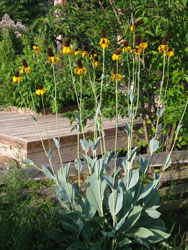Resource Library
Plant of the Week: Great Coneflower
The University of Arkansas System Division of Agriculture does not promote, support or recommend plants featured in "Plant of the Week." Please consult your local Extension office for plants suitable for your region.
Plant of the Week
Great Coneflower
Latin: Rudbeckia maxima

Wildflower gardens, when done well, are special places of natural beauty that attract birds, bees and all manner of wildlife to the garden. Gardeners with a need for order and control are often turned off by the natural look as plants flounce about, lean on each other and generally do their own things. This year I've been studying up on the black-eyed Susan tribe (the Rudbeckias) and want to tell you about the Great Coneflower, Rudbeckia maxima.
The great coneflower is one of about 25 species of Rudbeckias native to the United States. Gardeners everywhere know the annual black-eyed Susan (R. hirta) and its perennial cousin, R. fulgida, which look a lot alike and set the expectation for what a Rudbeckia should look like. The great coneflower is a perennial species that shares the general character of its more common black-eyed Susan kin, but is so very different.
This stiffly upright perennial grows 6 to 9 feet tall with the leaves a waxy, blue-gray color that gives rise to the common name of "cabbage coneflower," because the basal 14-inch long leaves have the same coloration of a cabbage in the spring before the plant begins sending up the flowering stems. As the plant flowers, the leaves get smaller as the stem elongates, remaining mostly on the lower half of the stem.
The flowers have the general configuration of a black-eyed Susan, except they are to 5 inches across with yellow-gold petals that droop downwards from a 2- to 3-inch long central brown cone. The flowering stems are sparsely branched, with two or sometimes three flowers produced per stem. Blooms are produced in late spring and early summer.
Rudbeckias are an exclusively North American genus that was given its Latin name by Linnaeus to honor a father and son, Olaus Rudbeck Sr. and Olaus Rudbeck Jr., who supported him when he first studied botany and medicine in the 1720s in Uppsala, Sweden.
The name black eyed Susan came into general use for the plant sometime after 1720 due to a popular ditty written that year by John Gay (1685 -1732), an English poet and ballad writer. In the poem that morphed into song Gay tells the tale of "Black-eyed Susan" coming on board a sailing ship to find her lover and bid him adieu before he sails off on a long voyage. The poem begins "All in the dawn the fleet was moor'd, the streamers waving to the wind, when Black-eyed Susan came on board, Oh where shall I my true love find?"
Rudbeckias would not have been common when European settlement first began on the eastern seaboard because these composites were confined to the prairie states at the time. But as the forests were cut and land cleared, black-eyed Susans began moving to all corners of the continent. Today R. hirta, the annual species, is one of the most recognizable wildflowers and is found in every state and Canadian province.
The great coneflower, though now widely grown as a wildflower in zones 5 through 9, has only migrated in gardens, not along roadsides. It is native to eastern Texas, western Louisiana and adjacent areas of Arkansas and Oklahoma, where it is found at the edge of forested areas or in prairie sites.
It does well in average garden soil with good wintertime drainage. While it will tolerate light shade, it is best in sunnier sites. Great Coneflower does not tolerate crowding, so is best planted where it has some space from other tall, aggressive wildflowers. Propagation is best by seed, with flowers appearing the second season. The cones are in themselves ornamental and are usually left in place. The seeds are favorites of gold finches and chickadees.
By: Gerald Klingaman, retired
Extension Horticulturist - Ornamentals
Extension News - July 16, 2010
The University of Arkansas System Division of Agriculture does not maintain lists of retail outlets where these plants can be purchased. Please check your local nursery or other retail outlets to ask about the availability of these plants for your growing area.